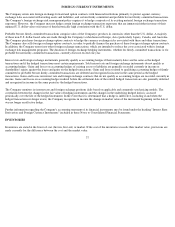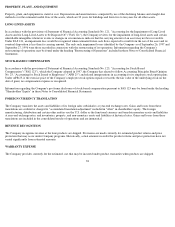Apple 1997 Annual Report Download - page 44
Download and view the complete annual report
Please find page 44 of the 1997 Apple annual report below. You can navigate through the pages in the report by either clicking on the pages listed below, or by using the keyword search tool below to find specific information within the annual report.treatment. The maturity date for these swaps is in February 2004. As of September 26, 1997, and September 27, 1996, interest rate swaps
classified as receive-fixed swaps had a weighted average receive rate of 6.04%. Weighted average pay rates on these swaps were 5.66% and
5.82% as of September 26, 1997, and September 27, 1996, respectively. The unrealized gains and losses on these swaps are deferred and
recognized in income as a component of interest and other income (expense), net in the same period as the hedged transaction. Deferred losses
on such contracts totaled approximately $4 million and $13 million as of September 26, 1997, and September 27, 1996, respectively.
The $100 million interest rate swap not qualifying as an accounting hedge requires the Company to pay Japanese yen at a fixed 0.6% interest
rate and receive Japanese yen at a floating rate based on 3 month LIBOR. This swap was intended to hedge against the interest rate risk related
to the Company's yen- denominated notes payable to banks. As most of the notes payable to banks were not renewed, the swap is no longer
effective as a hedge and therefore no longer qualifies as an accounting hedge.
Interest rate collars limit the Company's exposure to fluctuations in short-term interest rates by locking in a range of interest rates. An interest
rate collar is a no-cost structure that consists of a purchased option and a sold option. The Company receives a payment when the three-month
LIBOR falls below predetermined levels, and makes a payment when the three-month LIBOR rises above predetermined levels. Purchased
floors limit the Company's exposure to falling interest rates on its cash equivalents and short-term investments by locking in a minimum
interest rate. The Company receives a payment when interest rates fall below a predetermined level. A purchased floor generally qualifies for
hedge accounting treatment and is reported on the balance sheet at its premium cost, which is amortized over the life of the floor. The interest
rate collars and purchased floors are generally designated and effective as hedges against interest rate risk on the Company's securities
classified as available-for-sale and are carried at fair value in other current liabilities with the unrealized gains and losses recorded as a
component of shareholders' equity. Gains and losses are recognized in income as a component of interest and other income (expense), net in the
same period as the hedged transaction. Unrealized gains and losses on such contracts were immaterial as of September 26, 1997, and
September 27, 1996.
Sold interest rate option contracts require the Company to make payments should certain interest rates either fall below or rise above
predetermined levels. These contracts are generally not accounted for as hedges and are carried at fair value in other current liabilities with the
gains and losses recorded currently in income as a component of interest and other income (expense), net.
The foreign exchange forward contracts not accounted for as hedges are carried at fair value in other current liabilities with the gains and losses
recorded currently in income as a component of interest and other income (expense), net. The foreign exchange forward contracts that are
designated and effective as hedges are also carried at fair value in other current liabilities with gains and losses recorded currently in income as
a component of interest and other income (expense), net, against the losses and gains on the hedged transactions. All foreign exchange forward
contracts expire within one year.
The premium costs of purchased foreign exchange option contracts that are designated and effective as hedges are recorded in other current
assets and amortized over the life of the option. If the option contract is designated and effective as a hedge of a firmly committed transaction,
or a probable but not firmly committed transaction, then any gain or loss is deferred until the occurrence of the hedged transaction. Deferred
gains and losses on such contracts were immaterial as of September 26, 1997, and September 27, 1996. If the option contract is used to hedge
an asset or liability, then the option is carried at fair value in other current liabilities with the gains and losses recorded currently in income as a
component of interest and other income (expense), net, against the losses and gains on the hedged transaction. As of September 26, 1997,
maturity dates for purchased foreign exchange option contracts ranged from one to twelve months.
The net premium costs of purchased and sold foreign exchange option contracts not accounted for as hedges are recorded in other current assets
and amortized over the life of the option. The options are
41
























